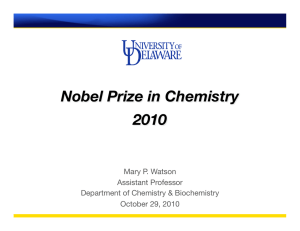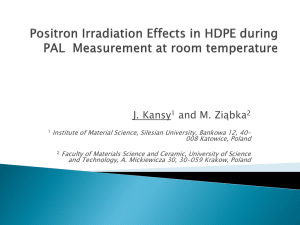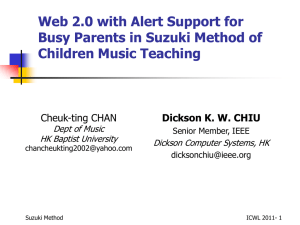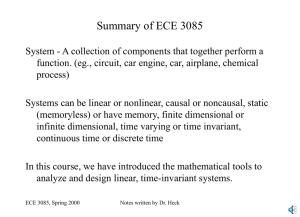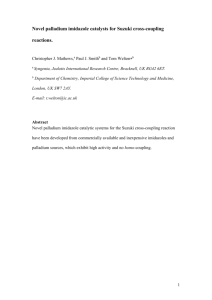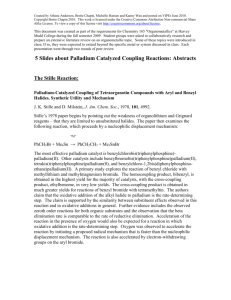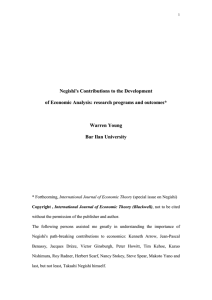Advantages of Suzuki reaction
advertisement
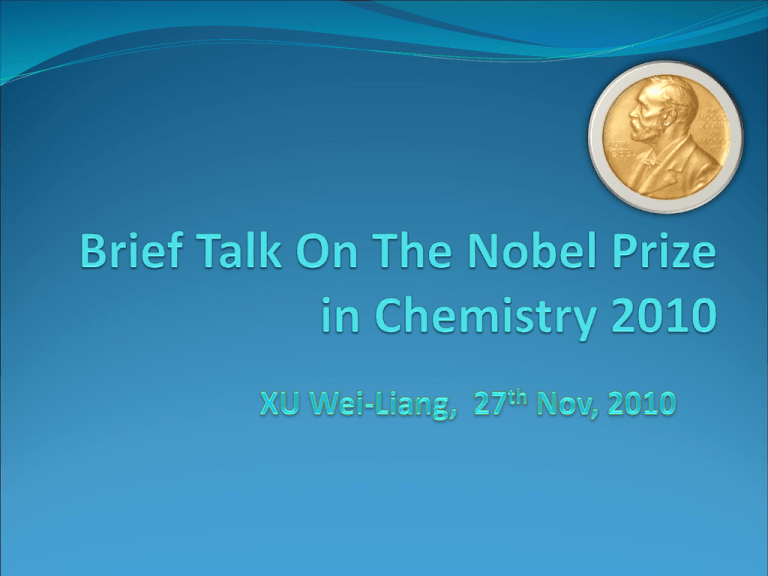
Three scientists shared this year’s Nobel Prize in Chemistry for developing techniques in coupling reaction catalyzed by Pd (0) Richard Heck: University of Delaware, Heck reaction, 1968 Ei-ichi Negishi: Purdue University, Negishi coupling, 1976 Akira Suzuki; Hokkaido University, Suzuki reaction, 1979 Heck reaction: X=I, Br, OTf, etc Negishi Couping: X, X’= Cl, Br, I, OTf M= Ni, Pd Suzuki Reaction: Y=OH, O-R Suzuki Reaction: Analysis of Elementary Steps in the Reaction Mechanism Oxidative Addition Transmetallation Reductive Elimination Experimental procedure for Suzuki reaction 1. Charge your reaction flask with your aryl bromide and your aryl boronate, then add your solvent (THF, dioxane, DMF and toluene are often used) and degas the reaction mixture either by freeze-pump-thaw cycling or simply by bubbling with an inert gas such as nitrogen or argon for 30 minutes. 2. Now add your palladium catalyst (Pd(PPh3)4 and PdCl2(PPh3)2 are often used) and then a degassed aqueous solution of your base (K3PO4, Na2CO3, K2CO3, Et4NOH are often used). Keep the reaction mixture under an inert atmosphere such as nitrogen or argon. 3. Your Suzuki reaction is now ready to take off. All you need to do is to heat it up to gentle reflux with good stirring to make sure that the biphasic reaction mixture is properly mixed. Your reaction will typically be completed after refluxing over night. 4. Work-up typically consists of an aqueous wash followed by column chromatography and recrystallisation to afford your desired product. Catalyst Organoborane: R-BY2 Synthesized by n-butyl lithium and halogen substituted compounds Advantages of Suzuki reaction: 1.Mild reaction condition 2.Tolerance of activative functional group 3.insensitity to moisture 4.Low toxicity Disadvantages of Suzuki reaction 1. Aryl chlorides are not usually not good substrates because they tend to react very slowly. Negishi Couping: mechanism Preparation of Organozinc reagent : 1.Direct reaction of organic halide with zinc or activated zinc. R-X Zn R-ZnX 2.Transmetallation of the corresponding organolithium or Grignard reagents with a zinc halide. ZnX2 R-Li RZnX+LiX ZnX2 R-MgX RZnX+MgX2 Experimental procedure for Negishi coupling The palladium catalyst (0.01 mmol Pd) is charged into the reaction vessel. 3iodobenzotrifluoride (144 mL,1 mmol) is then introduced, followed by addition of a THF solution of 4-methylphenylzinc iodide (0.5 M, 3 mL,1.5 mmol). The resulting mixture is stirred at 50 °C for 18 h, cooled, and then filtered. The resin is washed with THF (2 × 3 mL), the THF filtrates combined and evaporated. The evaporation residue is dissolved in a minimum amount of THF and filtered through a silica gel pad to remove any residual zinc compounds. The pad is rinsed with ether, and the combined ether filtrates evaporated. The crude product thus obtained is purified by flash chromatography on silica gel (column size 1.5 × 2.5 cm) using hexane as eluent. The purified product, 4-methyl-3’-trifluoromethylbiphenyl, is isolated as a colorless oil. Grignard Reagents and Organozinc halides Organozinc halides are milder ; react directly with the bromides or chlorides ; tolerate a variety of sensitive groups such as nitriles, esters, amides, ethers, sulfides, and ketones to give functionalized organozinc reagents. Examples for Negishi Reaction Extremely Active Catalyst for the Negishi Cross-Coupling Reaction J. E. Milne, S. L. Buchwald, J. Am. Chem. Soc., 2004, 126, 13028-13032. The First Negishi Cross-Coupling Reaction of Two Alkyl Centers Utilizing a Pd-N-Heterocyclic Carbene (NHC) Catalyst N. Hadei, E. A. B. Kantchev, C. J. O'Brien, M. G. Organ, Org. Lett., 2005, 7, 3805-3807. Negishi Coupling of Secondary Alkylzinc Halides with Aryl Bromides and Chlorides C. Han, S. L. Buchwald, J. Am. Chem. Soc., 2009, 131, 7532-7533. Heck reaction: One of the benefits of the Heck Reaction is its outstanding trans selectivity. Two different mechanism involved: 1.Neutral mechanism when X is strong a strong sigma donor such as Cl, Br, or I. 2.Cationic mechanism when X is OTf, Oac, or Ag+, Ti+, quaternary ammonium, and phosphonium salts are used to help displacement from halides neutral mechanism Cationic mechanism Examples for Heck Reaction Trifunctional N,N,O-terdentate amido/pyridyl carboxylate Pd(II) complexes were highly active and stable phosphine-free catalysts for Heck and room-temperature Suzuki reactions with high turnover numbers. M. L. Kantam, P. Srinivas, J. Yadav, P. R. Likhar, S. Bhargava, J. Org. Chem., 2009, 74, 4882-4885. New N-Heterocyclic Carbene Palladium Complex/Ionic Liquid Matrix Immobilized on Silica: Application as Recoverable Catalyst for the Heck Reaction B. Karimi, D. Enders, Org. Lett., 2006, 8, 1237-1240. Pd(quinoline-8-carboxylate)2 as a Low-Priced, Phosphine-Free Catalyst for Heck and Suzuki Reactions X. Cui, J. Li, Z.-P. Zhang, Y. Fu, L. Liu, Q.-X. Guo, J. Org. Chem., 2007, 72, 9342-9345. Disadvantages for Heck reaction: 1.Substrates used in the reaction cannot have beta hydrogens because they will undergo rapid beta hydride elimination to give olefins. √ × 2. Aryl chlorides are not usually not good substrates because they tend to react very slowly. The end
